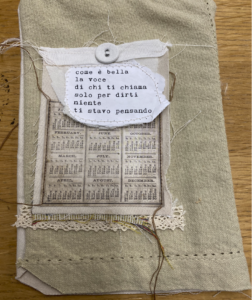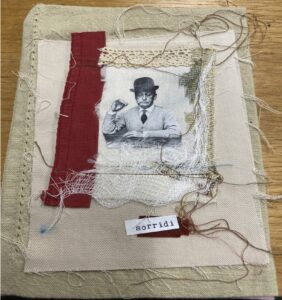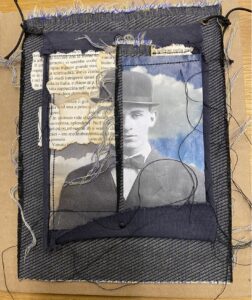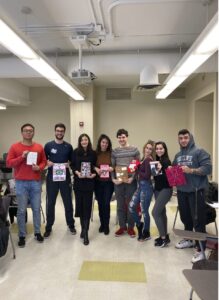Language Learning in Practice
Titolo del Progetto della classe. Maria Lai: Scrivere, tessere, comporre, tenendo per mano la lingua e la cultura.
Project/Italian 204. Maria Lai: Writing, weaving, composing, holding language and culture by the hand.

Language is multifaceted, like a crystal.
Language courses cannot be considered in isolation from “content courses.”
Language courses are “content courses” par excellence in which students are able to explore, discover and learn about the socio-cultural context that is strictly related to the language they learn while acquiring and developing their skills.
How can one think of a language divorced from the socio-political-cultural context that produces it?
When designing the syllabus for the class, I started to think about how I could better connect language and culture through an approach that privileged content over grammar.
___________________________________
Poetry, Visual Culture and the Arts
Poetry is a wonderful tool for examining the power of language and words but also as a way to elicit active responses from students. In preparation for the Lai project, I assigned a poem by Aldo Palazzeschi entitled “Rio Bo” that did not present many challenges from the linguistic point of view. This was a starting point to elaborate on the definition and differences between literal meaning (denotation) and symbolic meaning (connotation). This kind of practice allows us to further our reading of more difficult works.
E.g. What were the literal meanings and symbolic meanings of sentences such as “Tenendo per mano il sole” (Holding the sun by the hand) or “Tenendo per mano l’ombra” (Holding the shadow by the hand). How would it be possible to associate a physical word to a star? And thus what were the possible meanings that were necessarily metaphorical? And so on…Then more complicated poems were presented.
___________________________________
Il viaggio è la casa
Non solo la mia casa, ma quella di tutti noi.
Siamo sulla terra, che gira a circa trenta chilometri al secondo,in un viaggio che è pur sempre un viaggio speciale,
Dove non si distingue la partenza dal ritorno.
La vera nostalgia non è quella per un isola.
È l’ansia di infinito.
Maria Lai
The journey is my home.
Not only my home, but everyone’s.
We are on earth, which revolves at around 30 km a second,
On a journey that is always special,
Where you cannot distinguish the departure from the return.
True nostalgia is not for an island.
It is the anxiety for the infinite.
Trans. Eugenia Paulicelli
___________________________________
Students were introduced to the language of poetry and encouraged to explore another kind of materiality: that of words, their weight and resonance in our embodied relationship with life, reality, the world.
We read two poems by Giacomo Leopardi, A Silvia and L’Infinito. They listened to the poem recited by Vittorio Gassman, one of Italian cinema and theatre’s most respected actors. Following the reading, listening, research on vocabulary and use of arcaisms, students had to answer some questions.
___________________________________
Questions on poems by Maria Lai and Giacomo Leopardi (1798-1837).
1. Come descrive l’infinito Maria Lai nella sua poesia? (How does Lai describe infinity?)
2. Che rapporto esiste tra la casa e il viaggio? (What is the relationship between the home and the journey in Lai?)
3.Come descrive Lai, lo spazio della casa e lo spazio dell’infinito? (How does Lai describe the space of the home and the space of infinity?)
4. Nella poesia di Leopardi, come si descrive l’infinito? (In Leopardi’s poem, how is infinity described?)
L’Infinito by Giacomo Leopardi
Sempre caro mi fu quest’ermo colle,
E questa siepe, che da tanta parte
Dell’ultimo orizzonte il guardo esclude.
Ma sedendo e mirando, interminati
Spazi di là da quella, e sovrumani
Silenzi, e profondissima quiete
Io nel pensier mi fingo; ove per poco
Il cor non si spaura. E come il vento
Odo stormier tra queste piante, io quello
Infinito silenzio a questa voce
Vo comparando: e mi sovvien l’eterno,
E le morte stagioni, e la presente
E viva, e il suon di lei. Cosí tra questa
Immensità s’annega il pensier mio:
E il naufragar m’è dolce in questo mare.
This lonely hill was always dear to me,
and this hedgerow, which cuts off the view
of so much of the last horizon.
But sitting here and gazing, I can see
beyond, in my mind’s eye, unending spaces,
and superhuman silences, and depthless calm,
till what I feel
is almost fear. And when I hear
the wind stir in these branches, I begin
comparing that endless stillness with this
noise:
and the eternal comes to mind,
and the dead seasons, and the present
living one, and how it sounds.
So my mind sinks in this immensity:
and foundering is sweet in such a sea.
(translated by Jonathan Galassi)
___________________________________
Students were then asked to compose their own poems.
They first wrote in Italian, we did editing in class and made suggestions.
Then I asked them to give me their final versions, accompanied by their English translation.
This kind of exercise allowed them and us as a group to touch upon other layers hidden in words and language in general. This was also a chance to practice how to learn new vocabulary and understand translation as a process that involves the act of interpretation as something we do all the time as human beings.
Students explored translating how we feel and think about things in our native tongue and in the foreign language we are learning. In some cases the students’ mother tongue was not English, e.g. Chinese, Portuguese, Russian. Practice of this kind reveals our ability to navigate in different spaces and to experiment with and feel the materiality of words. Like a texture…
___________________________________
Poesia scritta da Iroda nella classe Italian 204
Cucite per recuperare,
Cucite per dimenticare le vostre ferite,
Cucite per ricordare la vostra provenienza
Dall’altrove
E per creare un percorso Nuovo,
Una nuova fiaba che si trasforma
Nella nuova realtà
In cui non c’è più la crudeltà.
Cucite per creare lenzuola ampie
Come l’orizzonte.
Esprimete la vostra caparbietà
Attraverso il filo che
Accomuna tessuti come umanità
La caparbità è un aggettivo perfetto per descrivere Maria Lai. Il percorso dell’artista era incredibile per le donne del suo tempo. L’artista e la scultrice l’ha sposata con il suo telaio, I suoi fili e I suoi aghi. Le trame intessute, le tele cucite e le lenzuola ampie sono I suoi figli. Apparentemente, l’idea di usare l’arte come il suo dispositivo per insegnare alle persone che dobbiamo essere accomunati attraverso l trame intessute e attraverso l’arte pubblica, è diventata la sua devozione.
___________________________________
Iroda/Pagina Cucita – Descrivere il Vostro progetto
Per il mio progetto artistico ho usato felro e cotone con elementi Ikat. Ho usato feltro Azzurro e beige perchè per me il colore Azzurro rappresenta il cielo, la libertà e, in certa misura, la purezza e la calamità e il beige mi ricorda della terra. I fili rossi simboleggiano il sangue e la vita, Azzurro enfatizza la libertà. Per me la libertà di scelta è una delle cose più important della vita. Il materiale Ikat ha diversi colori: rosa, giallo, bianco e grigio. Per me anche I colori della sciarpa hanno un significato. Il rosa è la felicità, il grigio è tristezza, il giallo è il sole e il banco è calamità e chiarezza mentale.
Ho tagliato una mia sciarpa per questo progetto. Gli ornamenti Ikat sono utilizzati nel mio paese di origine e soddisfano il requisite di utilzzare qualcosa di personale. Mi ricorda casa. È anche fatto a mano. Dunque a Maria Lai piaceva creare materiali e fare libri fatti a mano, quindi la sciarpa fatta a mano era un buon modo per renderle omaggio. Maria Lai mi ispira perchè era una donna che ha seguito I suoi sogni e non ha lasciato che gli stereotipi di genere si fcessero strada. Alla fine ho usato immagini di film e musica italiani. Il legame tra Ikat e la cultura italiana rappresentano la diversità
___________________________________
Eduardo Marino, Le pagine della vita
Le esperienze sono come fili che si uniscono per formare la persona che siamo,
Sono come il sottotitolo di un libro che definisce le nostre caratteristiche,
Il modo in cui vediamo le cose,
Il modo in cui ci vestiamo,
Il modo in cui parliamo,
Però soprattutto le cose cucite su ogni pagina che segnano la nostra storia per sempre
E indicano la nostra identità
E indicano chi diventiamo
___________________________________
Eduardo Marino / Pagina cucita
In questo progetto, ho fatto una pagina
Utilizzando una maglietta Bianca del Queens College Athletics, cucita su un materiale più solido, anche bianco.
Ho scelto il tema del Brasile perchè sono brasiliano e volevo rappresentare il mio paese insieme alla mia partecipazione alla squadra di tennis negli Stati Uniti.
Inoltre ho selezionato un filo giallo e anche il colore verde perchè sono I colori del Brasile.
Dopo, ho scritto una parte di una canzone brasiliana molto famosa e anche la sua traduzione in italiano. Per finire, ho scelto due immagini che mostrano località turistiche molto conosciute in Brasile, una di Cristo Redentore, a Rio de Janeiro, e un’altra del Ponte Estaiada, a San Paolo. Maria Lai mi ha ispirato a fare questo progetto perchè ho usato materiali diversi per rappresentare parte della mia identità su una pagina cucita, come faceva con le sue opera.
___________________________________
Sun Youtian/ his fabric book
Il mio lavoro è un fumetto. Per prima cosa ho cucito un libro con stoffa e ricami. Quindi ho usato un computer per disegnare e ho creato una serie di fumetti. Quando ho realizzato questo fumetto, sono stato influenzato da Maria Lai, che ha usato il Ricamo per scrivere parole illegibili sul tessuto. Il mio lavoro è differente. Non ho creato un testo illegibile, perchè sono appassionato per l’apprendimento delle lingue straniere. Ho usato una parola diversa per ogni lingua, “Rien” (niente) in francese, “mano” in italiano, il terzo in Tedesco “Mehr” (di più) il quarto in giapponese … (occhi); e la quinta è cinese che significa “complete/tutto”. Dunque dal nulla abbiamo completato il progetto.
___________________________________
Poesia di Maria Costa- Il mare e I venti.
Mare, infinito mare,
Impossibile non cantare
I tuoi mutamenti
Ieri feroce come una fiera ferita
Forti venti agitavano le onde
Oggi calmo e tranquillo
Una brezza fresca accarezza la mia faccia
E tutto il mio corpo soavemente abbraccia
Sempre cambiando, mai lo stesso
Schiavo dei venti e delle maree
Nessuno saprà come sarà domani
Inaspettate sorprese ogni giorno crea.
Sea, endless sea,
Impossible not to sing
Your changes
Yesterday wild as a wounded beast
Strong winds agitated the waves
Today calm and serene,
A fresh breeze caresses my face
And gently embraces my whole body
Always changing, never the same,
Slave of winds and tides
No one will ever know how you will be tomorrow
Creating unexpected surprises every day
___________________________________
Sun Youtian – Poesia
La vita è un filo dell’ago che si insieme si intrecciano.
Il tempo passa, è come un flusso d’acqua.
Tesserò il tuo future con un ago,
Sei lontano, ma mi sembra vicino.
Sono seduto da solo in una stanza vuota,
La tessitura appartiene al nostro futuro.
Quando torni.
Sarò già pieno di capelli bianchi.
Tessere ancora la tua storia tra le mani.
___________________________________
John Sullivan, “Ruminations in Isolation”
Like huddled stars
In dusky sky,
Which seem intimate
To the eye,
Are really very far apart,
So act our friends
Who hide away
Their truest selves
From light of day,
In the darkest skies of their own hearts.
Georgine Ingner
Mother Earth
How much she is sacred
Mother Earth
How she protects us
Nurtures us
Gives to us
It is a pity that humanity
Thinks little of her
We are dirty
We waste
While we watch her die.
___________________________________
John Sullivan, Elucubrazioni sull’isolamento
Come le stelle
Raggruppate nel cielo,
Che sembrano vicine
L’una all’altra,
Ma veramente sono lontane,
Cosí I nostril amici
Che nascondono le loro verità
Non mostrano se stessi,
Nella luce del giorno
Nella profondità dei loro infiniti cieli notturni.
___________________________________
Gerorgine Ingber, La Madre Terra
Quanto è sacra
La Madre Terra
Come ci protegge
Ci nutre
Ci dà
È un peccato che l’umanità
Pensi poco a lei
La sporchiamo
Sprechiamo
Mentre la guardiamo morire
___________________________________
The midterm exam was a project to be done in steps and involved working with different media.
1. read the brochure on Maria Lai’s exhibition at the MAXXI in Rome.
2. do research on the artist. Prepare a power-point with the most important aspects oh her life and work.
3 .select one of her works and comment on it, say why it was important etc.
4. select material for their own textile work that together we decided to call “Pagina cucita” (sewn page)
We brought to class different fabrics and we discussed the possibilities.
We discussed how to compose the page, how to use threads or other kinds of material, a photo, a poem, etc.
One of the students attending the class, Georgine Ingber (Director of Creative Services, Communication and Marketing at Queens College) who is also an artist brought to class her first experiment (see picture in following slide) and we examined it together. Her work and interpretation of the themes we discussed was an inspiration.
Each student completed their page and as a further step they had to describe their project and explain their choices.
We practiced writing this text, the vocabulary, grammar etc.
___________________________________
The Final Exam
The Final Exam contained a reflection on the Lai project that intersected with art, material culture, fashion, poetry and the history of women.
As one of the questions, I included a paragraph with the following quotation: “Il rapporto con l’infinito è essenziale per essere umani… La bellezza e l’arte, apparentemente cosí inutile, ci salvano la vita. L’arte come la fragile barca di carta che deve affrontare l’infinito.” dice Maria Lai. Ritroviamo cosí quell’idea di infinito che insieme all’idea di legame e di relazione, è al centro del lavoro di Maria Lai.[…] Il suo filo è idealmente senza fine perchè allude al filo dell’arte che non si esaurisce mai. Oltrepassa dunque I confini del telaio, del lenzuolo, del libro, della pagina e ci conduce tenendo per mano l’ombra e tenendo per mano il sole verso altri orizzonti, altri spazi, altri mondi (Elena Pontiggia).
___________________________________
Translation of the previous paragraph.
The relationship with infinity is essential in order to be human…Beauty and art, apparently useless, save our life. Art as a fragile paper boat that must face infinity… (says Maria Lai). Her thread (FILO) ideally has no limits because it alludes to the thread of art that is never exhausted. It goes beyond the borders of the loom, of the book, of the bed sheets, of the page and leads us towards other horizons, other worlds, other spaces while we hold the hand of the shadow and of the sun. (Elena Pontiggia)
___________________________________
___________________________________
A selection of sentences written by the students
Veramente non possiamo vivere senza l’arte, ma questa vita sarà più triste e grigia. Persino le persone primitive usavano dipinti rupestri. […] L’arte può ispirarci, eccitarci, provocarci, ma alla fine è come dicono I russi, è un balsamo per la propria anima. Trova sempre un modo per connetterci. […]
Anche se trovo che tutte le opere di Maria Lai siano interessanti e insolite, uno dei suoi progetti che mi ha parlato di più è quello di “Legarsi alla montagna” un progetto di arte pubblica relazionale. Sono rimasta sorpresa dal suo scopo. Nastri blu come tante strisce di lenzuola che coprivano le stradine e le montagne del suo paese, Ulassai. Questi nastri, da un lato hanno collegato la comunità rendendola più forte e dall’altra per il contrasto di colori e l’ampiezza geografica, sembrava infinito e liberatorio. per i bambini e le persone del paese. Il progetto stesso crea “l’ansia di infinito” come infiniti sono gli orizzonti e la conoscenza che possiamo ottenere durante la nostra vita. (Iroda)
___________________________________





